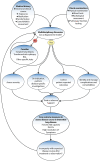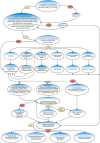Interstitial lung disease: a review of classification, etiology, epidemiology, clinical diagnosis, pharmacological and non-pharmacological treatment
- PMID: 38698783
- PMCID: PMC11063378
- DOI: 10.3389/fmed.2024.1296890
Interstitial lung disease: a review of classification, etiology, epidemiology, clinical diagnosis, pharmacological and non-pharmacological treatment
Abstract
Interstitial lung diseases (ILDs) refer to a heterogeneous and complex group of conditions characterized by inflammation, fibrosis, or both, in the interstitium of the lungs. This results in impaired gas exchange, leading to a worsening of respiratory symptoms and a decline in lung function. While the etiology of some ILDs is unclear, most cases can be traced back to factors such as genetic predispositions, environmental exposures (including allergens, toxins, and air pollution), underlying autoimmune diseases, or the use of certain medications. There has been an increase in research and evidence aimed at identifying etiology, understanding epidemiology, improving clinical diagnosis, and developing both pharmacological and non-pharmacological treatments. This review provides a comprehensive overview of the current state of knowledge in the field of interstitial lung diseases.
Keywords: hypersensitivity pneumonitis; idiopathic pulmonary fibrosis; interstitial lung disease; nonspecific interstitial pneumonia; sarcoidosis.
Copyright © 2024 Althobiani, Russell, Jacob, Ranjan, Folarin, Hurst and Porter.
Conflict of interest statement
The authors declare that the research was conducted in the absence of any commercial or financial relationships that could be construed as a potential conflict of interest.
Figures






References
-
- Travis WD, Costabel U, Hansell DM, King Jr TE, Lynch DA, Nicholson AG, et al. . An official American Thoracic Society/European Respiratory Society statement: update of the international multidisciplinary classification of the idiopathic interstitial pneumonias. Am J Respir Crit Care Med. (2013) 188:733–48. 10.1164/rccm.201308-1483ST - DOI - PMC - PubMed
-
- Raghu G, Remy-Jardin M, Richeldi L, Thomson CC, Inoue Y, Johkoh T, et al. . Idiopathic pulmonary fibrosis (an update) and progressive pulmonary fibrosis in adults: an official ATS/ERS/JRS/ALAT clinical practice guideline. Am J Respir Crit Care Med. (2022) 205:e18–47. 10.1164/rccm.202202-0399ST - DOI - PMC - PubMed
Publication types
LinkOut - more resources
Full Text Sources
Medical

